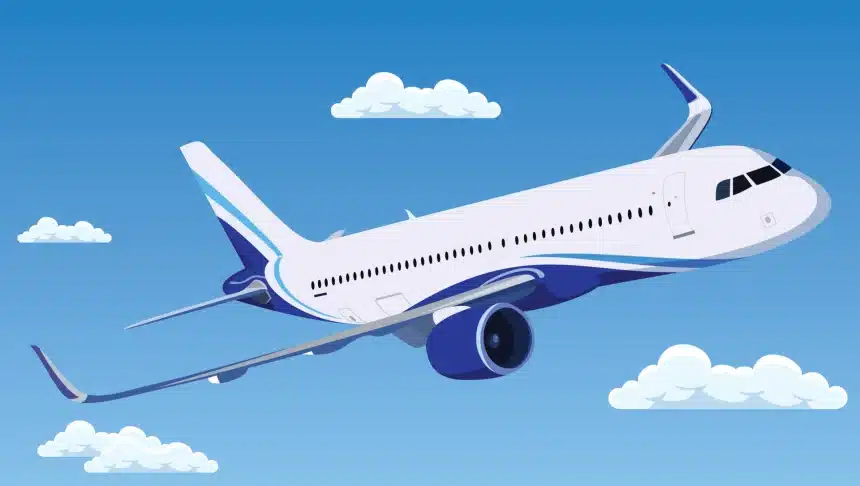There are many facts about airplanes that you definitely didn’t know, and in this article, we have put some 7 strange facts together about airplanes which will interest you.
Airplanes have revolutionized the way we travel, allowing us to reach faraway destinations in a matter of hours. But did you know that airplanes are also home to some of the most fascinating and strange facts?
From their origin to how they fly, and even the training pilots undergo, there is so much more than meets the eye when it comes to these flying machines. So fasten your seatbelts and get ready for takeoff as we explore 15 strange facts about airplanes that you definitely didn’t know!
The origin of airplanes
The origin of airplanes dates back to the late 19th century when two brothers, Orville and Wilbur Wright, embarked on their quest to create a flying machine. They were inspired by the idea of flight after seeing gliders in action.
The Wright brothers’ first successful flight took place on December 17, 1903, in Kitty Hawk, North Carolina. Their aircraft was a biplane with wings made of spruce wood and covered in muslin fabric. The engine had only 12 horsepower but was enough to power the plane for a distance of 120 feet at an altitude of just over ten feet.
Their invention sparked worldwide interest and soon led to further innovations such as jet engines and air travel becoming accessible for commercial use.
Today’s airplanes are vastly different from those early models created by the Wright Brothers. With modern technology advancements, we can now fly faster than ever before while maintaining safety standards that have been improved upon throughout decades of research and development.
How airplanes fly
Have you ever wondered how airplanes defy gravity and stay up in the sky? It all comes down to four basic forces: lift, weight, thrust, and drag.
Firstly, lift is created by the wings of an airplane. The shape of these wings allows air to flow over them faster than underneath, creating a difference in air pressure that lifts the aircraft off the ground.
Secondly, weight is simply the force of gravity pulling down on the airplane. To keep it flying level and steady at a desired altitude, pilots adjust their speed or angle of attack accordingly.
Thrust provides forward motion for an airplane through its engines or propellers. This force must be greater than drag – which opposes motion through air resistance – for an aircraft to take off and maintain flight.
Control surfaces such as flaps and rudders enable pilots to manipulate these forces and steer their planes in different directions.
Understanding how airplanes fly requires knowledge about these fundamental principles of physics combined with intricate engineering design.
How an airplane is controlled
Pilots have a variety of controls at their disposal to effectively maneuver an airplane through the skies. The most important control is the yoke, which is similar to a steering wheel in a car and allows the pilot to control the plane’s pitch and roll.
To change altitude, pilots use either the elevators or stabilizers located on the tail of the airplane. The elevators are small flaps that move up and down, while stabilizers are larger wings that tilt up or down.
Additionally, pilots use throttle controls to increase or decrease engine power for takeoff, cruising speed, and landing. These controls can affect both airspeed and altitude when used correctly.
There are rudder pedals that allow for directional control during flight. By pressing on one pedal or another with their feet, pilots can turn left or right as needed.
Mastering these various controls takes extensive training and practice but ultimately gives skilled pilots complete command over every aspect of an aircraft’s motion through airspace.
The parts of an airplane
An airplane is made up of several important parts that work together to make it fly efficiently. These parts are carefully designed and engineered to ensure the safety and comfort of passengers during flights.
One of the most essential parts of an airplane is the wings. They are responsible for providing lift, which enables the plane to take off from the ground and stay in flight. The shape and size of these wings also affect how quickly or slowly an airplane can fly.
Another crucial part is the fuselage, which houses both passengers and cargo. It serves as a supporting structure for other components such as engines, landing gear, tail assembly, wing attachment points, among others.
The cockpit or flight deck is where pilots sit during flights. It contains all necessary controls for steering, navigation systems, communication devices like radios or transponders that enable them to communicate with air traffic control towers on land when needed.
The engines provide thrust necessary for an airplane’s movement through the air. Most modern aircraft use turbofan engines that combine a turbine engine with fan blades at its front end creating high pressure airflow over its surface area making it more fuel-efficient than older designs using jet propulsion alone.
There’s also landing gear consisting wheels attached underneath each wing which keeps airplanes steady while they’re on the ground before takeoff or after landing. In some cases this includes retractable nose-wheels too used during take-off lifts nose up so pilot can see runway better before taking off!
Interesting facts about airplane engines
Airplane engines are the heart of an aircraft and play a crucial role in providing power for takeoff, climb, cruise, and landing. Here are some interesting facts about airplane engines that you probably didn’t know.
Firstly, did you know that modern jet engines can suck in enough air to fill a large sports stadium in just one second? These powerful machines use this air to mix with fuel and create the necessary thrust required for flight.
Secondly, most commercial airliners today use turbofan engines. These types of engines have a fan at the front which helps compress incoming air before it reaches the actual engine core. This design makes them more efficient and quieter compared to older designs.
Thirdly, airplane engines require extreme precision during manufacturing as even small deviations from design specifications can lead to catastrophic failures. For example, turbine blades within an engine spin at incredibly high speeds (upwards of 10 thousand rotations per minute) which could cause significant damage if they were not properly balanced.
Airplane manufacturers such as Boeing or Airbus work closely with engine manufacturers like General Electric or Rolls Royce to develop customized solutions specific to their airplanes. In fact, each type of aircraft typically has its own unique engine model designed specifically for optimal performance in terms of speed and efficiency.
These interesting facts highlight how important airplane engines are when it comes to aviation technology – without them we would not be able to travel thousands of miles across continents in just a few hours!
The history of the Wright brothers
The Wright brothers, Orville and Wilbur, are famous for inventing the world’s first successful airplane. Born in Ohio in the late 1800s, they had a passion for flying from a young age. Their journey to creating an airplane was not easy; it took years of experimentation and trial and error.
In 1903, they finally achieved their goal by designing and building a powered aircraft that successfully lifted off the ground. The flight only lasted a mere 12 seconds but it was enough to make history.
Their invention became incredibly popular and caught the attention of governments around the world who wanted to incorporate airplanes into their military operations. The Wright brothers continued to improve their designs over the years until they were able to create planes that could fly faster, longer distances.
Sadly, both brothers passed away before seeing how much impact their invention would have on modern society. However, their legacy lives on as aviation continues to grow every year thanks largely due to their groundbreaking work.
How pilots are trained
Becoming a pilot is no easy feat, and it requires extensive training before one can take to the skies. Pilots are trained in various aspects of flight including navigation, meteorology, communications and aircraft systems. The first step in becoming a pilot is acquiring a private pilot’s license which allows you to fly small planes on your own.
Once you have obtained this license, further training takes place through advanced courses such as instrument flying and multi-engine rating. These courses teach pilots how to navigate using instruments alone and how to handle planes with more than one engine respectively.
In addition to these technical skills, pilots must also undergo rigorous physical and psychological testing. They must be able to maintain focus for long periods of time while under pressure, make quick decisions in emergency situations and remain calm under stress.
All pilots must log a certain number of hours flying before they can obtain their commercial license which allows them to fly for airlines or other organizations. The amount of time required varies depending on the country but usually ranges between 1,500-2,000 hours.
It takes dedication and hard work for someone to become an experienced pilot capable of handling any situation that may arise during flight.
Conclusion
So there you have it, 15 strange and fascinating facts about airplanes that you probably didn’t know before. From the origin of airplanes to how they fly and are controlled, from interesting facts about airplane engines to the history of the Wright brothers, we hope this article has provided a fun and informative look into the world of aviation.
It’s incredible to consider just how far air travel has come in such a short amount of time since its inception over a century ago. With new advancements in technology and design happening all the time, who knows what other amazing feats will be achieved by aircraft in years to come?
Whether you’re an aviation enthusiast or simply someone with an interest in learning more about these wonderful machines that take us soaring through the skies, we hope this article has given you some insights into just how incredible airplanes really are.








